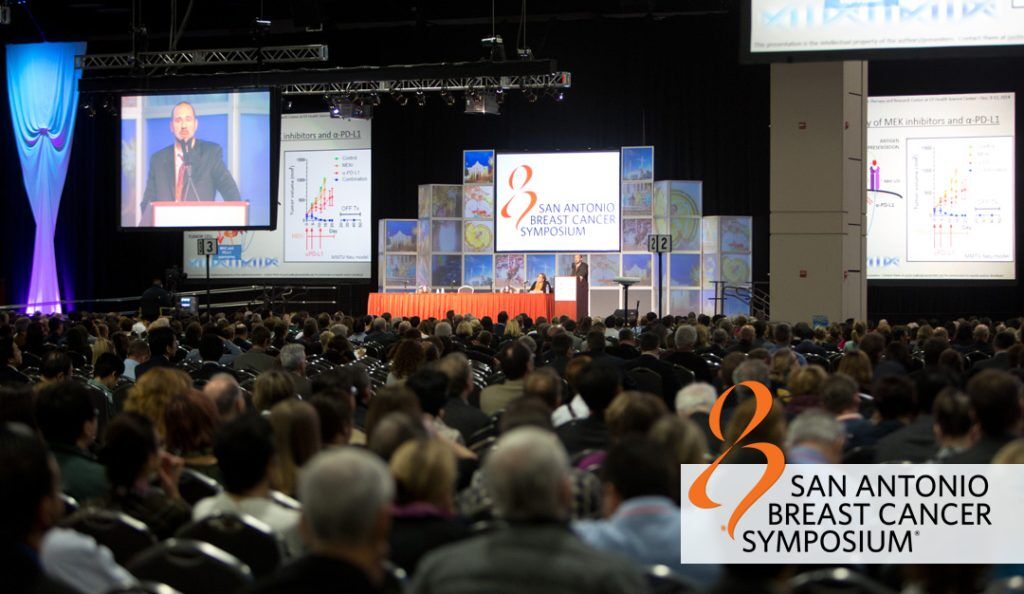Our highlights of the most compelling research at the annual meeting.
The 37th annual San Antonio Breast Cancer Symposium (SABCS) took place on December 9-13. The five-day program is attended by academic and private researchers, health professionals and advocates from around the world. This unique meeting provides a forum of communication and education in advances in clinical, translational and basic breast cancer research covering topics in experimental biology, etiology, prevention, and diagnosis.
We’ve compiled a four-part series to share the most compelling research presented at the conference. Read on for part one and stay tuned for the rest.
The Era of Genomics and Breast Cancer Research
While SABCS does not select a theme for its annual meeting, it was hard to miss how genome-driven research — specifically our ability to sequence and analyze whole tumor genomes (DNA) — is informing how we approach persistent challenges in breast cancer, such as drug resistance, breast cancer recurrence and metastasis and improving our understanding of risk and prevention.
Drug Resistance
The meeting kicked off with a talk from Dr. Matthew Ellis on how genome-driven studies (studies that use information about mutated genes) may provide answers to questions in drug resistance and could lead to the development of better prevention and treatment strategies.
Dr. Ellis described work from his group and others that utilize advanced DNA sequencing techniques and a specialized model called PDX (Patient-Derived Xenografts) to study how mutations in the estrogen receptor (ESR1) and HER2 genes may influence response to therapies.
Many ongoing correlative studies are using similar genetic and molecular profiling methods on tumor tissue and other biological samples collected as part of clinical trials. These studies are identifying gene markers or multi-gene signatures that may help to predict response to treatment for future patients or identify molecular programs that become activated during treatment that make tumors resistant to the therapy. This information may be particularly relevant as more targeted therapies become available and combination therapy approaches are considered.
Metastasis
The PDX model is another example of how genomics is changing how we study metastasis. Pioneered by Dr. Alana Welm’s group, PDX are essentially human tumors grown outside of humans. The technique involves taking small pieces of tumor from a breast cancer patient and transplanting it to grow in the laboratory.
Using DNA sequencing and molecular profiling methods, Dr. Welm and her colleagues have shown that PDX tumors are genetically and biologically identical to the human tumors from which they were taken. While no model is perfect, the PDX system allows scientists to study how gene mutations in the patient tumor affect response to treatment and the likelihood of metastasis, making it a unique model for prevention and treatment of metastasis.
The PDX model will also serve as an important tool in the BCRF’s Founder’s Fund initiative, which is focused on advancing our understanding of breast cancer metastasis. While speaking at an advocate briefing during SABCS, Dr. Suzanne Fuqua highlighted the importance of PDX in determining why some tumors spread and others do not and identifying new strategies to treat and prevent metastasis, and she acknowledged the foresight of BCRF in making this critical area a priority.
Tumor Heterogeneity
Tumor heterogeneity, or variety within a single tumor or among different tumors, is one of the most perplexing challenges in treating breast cancer and preventing metastasis. It is well recognized that breast cancer is a very heterogeneous disease — there are at least five major subtypes of the disease that can be further broken into subclasses based on genetic profiles and prognoses.
Through large-scale genomic and tumor profiling studies, scientists are gaining better insight into the extent of this complexity, and the studies presented at SABCS highlighted unequivocal evidence for the existence of diverse cells types within a tumor that behave very differently.
Summarizing notable advances in the last year, Dr. Charlotte Kuperwasser highlighted the work of Drs. Kornelia Polyak, Daniel Haber, Andrew Ewald and others who have provided valuable insight into the cellular makeup of breast tumors. This includes new information on the regulation of tumor stem cells and evolution of tumor cell clonal populations (groups of cells from a single genetic background) that work cooperatively to enable tumor development and growth. These studies have helped us to understand that there are many genetic programs operating within a tumor.
Along with identifying classes of cells within a tumor, advances in micro-fluidic technology have made it possible to isolate single tumor cells and even fragments of circulating tumor DNA from the blood of cancer patients, in what is called a liquid biopsy. Dr. Ben Ho Park talked about how coupling this technology with genomic analysis of tumor cells and DNA can be used to determine whether a patient is likely to benefit from a specific therapy, follow cancer during treatment and identify the presence of micro metastases.






